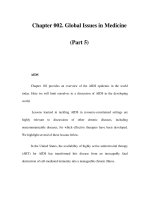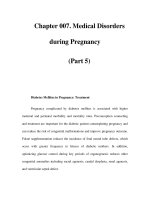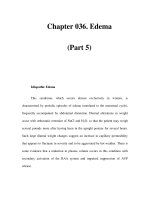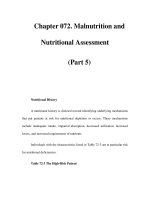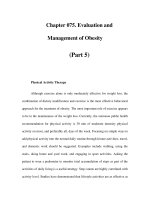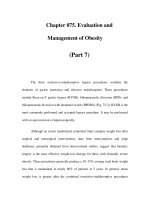Chapter 098. Iron Deficiency and Other Hypoproliferative Anemias (Part 5) ppsx
Bạn đang xem bản rút gọn của tài liệu. Xem và tải ngay bản đầy đủ của tài liệu tại đây (22.85 KB, 5 trang )
Chapter 098. Iron Deficiency and Other
Hypoproliferative Anemias
(Part 5)
Clinical Presentation of Iron Deficiency
Certain clinical conditions carry an increased likelihood of iron deficiency.
Pregnancy, adolescence, periods of rapid growth, and an intermittent history of
blood loss of any kind should alert the clinician to possible iron deficiency. A
cardinal rule is that the appearance of iron deficiency in an adult male means
gastrointestinal blood loss until proven otherwise. Signs related to iron deficiency
depend on the severity and chronicity of the anemia in addition to the usual signs
of anemia—fatigue, pallor, and reduced exercise capacity. Cheilosis (fissures at
the corners of the mouth) and koilonychia (spooning of the fingernails) are signs
of advanced tissue iron deficiency. The diagnosis of iron deficiency is typically
based on laboratory results.
Laboratory Iron Studies
Serum Iron and Total Iron-Binding Capacity
The serum iron level represents the amount of circulating iron bound to
transferrin. The TIBC is an indirect measure of the circulating transferrin. The
normal range for the serum iron is 50–150 µg/dL; the normal range for TIBC is
300–360 µg/dL. Transferrin saturation, which is normally 25–50%, is obtained by
the following formula: serum iron x 100 ÷ TIBC. Iron-deficiency states are
associated with saturation levels below 18%. In evaluating the serum iron, the
clinician should be aware that there is a diurnal variation in the value. A
transferrin saturation >50% indicates that a disproportionate amount of the iron
bound to transferrin is being delivered to nonerythroid tissues. If this persists for
an extended time, tissue iron overload may occur.
Serum Ferritin
Free iron is toxic to cells, and the body has established an elaborate set of
protective mechanisms to bind iron in various tissue compartments. Within cells,
iron is stored complexed to protein as ferritin or hemosiderin. Apoferritin binds to
free ferrous iron and stores it in the ferric state. As ferritin accumulates within
cells of the RE system, protein aggregates are formed as hemosiderin. Iron in
ferritin or hemosiderin can be extracted for release by the RE cells, although
hemosiderin is less readily available. Under steady-state conditions, the serum
ferritin level correlates with total body iron stores; thus, the serum ferritin level is
the most convenient laboratory test to estimate iron stores. The normal value for
ferritin varies according to the age and gender of the individual (Fig. 98-3). Adult
males have serum ferritin values averaging about 100 µg/L, while adult females
have levels averaging 30 µg/L. As iron stores are depleted, the serum ferritin falls
to <15 µg/L. Such levels are diagnostic of absent body iron stores.
Figure 98-3
Serum ferritin levels as a function of sex and age.
Iron store depletion
and iron deficiency are accompanied by a fall in serum ferritin level below 20
µg/L. (From Hillman et al, with permission.)
Evaluation of Bone Marrow Iron Stores
Although RE cell iron stores can be estimated from the iron stain of a bone
marrow aspirate or biopsy, the measurement of serum ferritin has largely
supplanted bone marrow aspirates for determination of storage iron (Table 98-3).
The serum ferritin level is a better indicator of iron overload than the marrow iron
stain. However, in addition to storage iron, the marrow iron stain provides
information about the effective delivery of iron to developing erythroblasts.
Normally, when the marrow smear is stained for iron, 20–40% of developing
erythroblasts—called sideroblasts—will have visible ferritin granules in their
cytoplasm. This represents iron in excess of that needed for hemoglobin synthesis.
In states in which release of iron from storage sites is blocked, RE iron will be
detectable, and there will be few or no sideroblasts. In the myelodysplastic
syndromes, mitochondrial dysfunction can occur, and accumulation of iron in
mitochondria appears in a necklace fashion around the nucleus of the erythroblast.
Such cells are referred to as ringed sideroblasts.


